Peter Dornauf – 6 March, 2024
None of the public sculptures currently and temporarily on display in the Boon Sculpture Trail 2024, (organized by Nancy Caiger and curated by Claire Ulenberg), located within Hamilton Central, and part of the Hamilton Arts Festival, should alarm anyone. Delight, intrigue, puzzle perhaps, but not cause dyspepsia.
Barbara Wheeler, Stuart Bridson, Anya Whitlock, Chris Moore, Gaye Jurisich, Te Rongo Kirkwood, Paul Darragh, Natalie Guy, Peata Larkin, Julie Moselen, Ben Pearce, and others
Boon Sculpture Trail 2024
Curated by Claire Ulenberg
February 3 - March 31, 2024
Public sculpture. It’s a curious beast. One would think that all sculpture is public in that it is accessible to everyone whether inside some gallery space or outside in the civic square.
What then do we mean by the term? Do we mean public sculpture is more public? Probably. It’s out in the street. You can’t get more public than that. It’s also probably a little more orthodox, having to pass through the monitoring hands of bureaucrats and civil servants. We don’t want to frighten the horses or alarm the citizens, do we?
None of the public sculptures currently and temporarily on display in the Boon Sculpture Trail 2024, (organized by Nancy Caiger and curated by Claire Ulenberg), located within Hamilton Central, should alarm anyone. Delight, intrigue, puzzle perhaps, but not cause dyspepsia.
Take the oversized egg of Barbara Wheeler, Move Me, made of rafia, denim, willow cane and a few flowers woven round a large steal frame. One immediately associates the rough weave with a bird nest, and from there the notion of egg, and then, perhaps, not too big a leap, the birth of the universe, as we have it in several mythologies from cultures around the world. And then, to take it further, the concept of nurture, such a pressing need in our present planetary economy.
Ironically, not too far away in location is a giant sculpture of a huia bird, symbol and proof of man’s exploitive exploits and abuses. Anya Whitlock’s large polystyrene sculpture presents the bird in regal fashion, with golden claws, constructed and painted in such a way as to evoke association with ancient monuments from say Egypt or Greece.
Chris Moore’s tree sculpture, (fabricated steel and aluminum), continues the theme, his large metal configured plant with bulbous leaves and sinuous stem positioned as it is immediately adjacent to a real tree.
Nature and its preservation continue with Veil by Gaye Jurisich where she is interested in delineating the very ordinary elements of the earth. For her location, she chose a slight undulating piece of public lawn and set up a grid structure involving straight lines of blue cord pegged into the ground. Over time, the grass has grown up and been left to naturally flourish. The ordinary thus becomes, in the process, special.
Located close to the Waikato River are positioned two sculptures that have direct links to early ancestral Māori culture. One by Te Rongo Kirkwood, Hinaki Net, which is what it is, except that it is made of aluminium rods and paua, is large and imposing, beautifully crafted, an honouring and homage to a world past and all it meant while incorporating an ecological theme for the present. The other work is a stylized waka by Peata Larkin, employing chevron shapes that are primal in Māori design, positioned ready to launch into the river, bringing modern techniques and materials together (powder coated black steel), with ancient cultural artefact to help celebrate both.
Of the more formal sculptures, Paul Darragh’s Progress Pillar, treated plywood and paint, gives a nod to modernist aesthetics and their association with optimistic agendas. There’s a Pop Art flourish to the designs painted in bright high gloss colours on the column that quote popular geometric designs from mid-century modernism. A ‘totemic quilt’ is how the artist describes it, “symbolizing pride for our local rainbow community.”
Natalie Guy is another who is also enamoured by the same artistic forms and shapes from the period. Her work, The Imaginary Mountain, references architectural elements that featured mid-century with her aluminum paneled diptych echoing the rooflines from two buildings: one local, from Hamilton (Te Rahui Tane Hostel, Hamilton East, architect Rod Smith); the other in Italy (Santas Maria Assunta, architect Alvar Aalto).
That same love of geometrics is seen in Julie Moselen’s Union, a vertical dual plinth (Corten steel, gold leaf), that takes its inspiration from the historical Union Bridge that links Hamilton East and West. And Ben Pearce with his riff on Chris Booth and/or Brancusi, does the same with his stacked ‘stones’ made from Corten steel welded plates.
The joker in the pack must be Stuart Bridson who specializes in the quirky conjunction of disparate and unrelated forms, butted together to create ‘nonsense’ structures, full of contradictions that somehow cohere anyway. Deconstruction possesses here its own kind of beauty, bringing together wood, concrete, plater, stainless steel piping, plastic, fiberglass kwila and fine pumice. There is a conversation inherent in Hey You. According to the artist it runs like this. ‘Hey you. I feel I know you, but I am afraid you might not know anything about me or who I really am.‘ That’d be right, Stuart. Almost.
Altogether 20 sculptural works are scattered around the central city precincts, and an accompanying exhibition of sculptural pieces is also exhibited by the same artists at ArtsPost Gallery. Each in their own fashion has responded to the curator’s call to reflect on the theme of ‘this place’ and have done so with imaginative flair.
Peter Dornauf
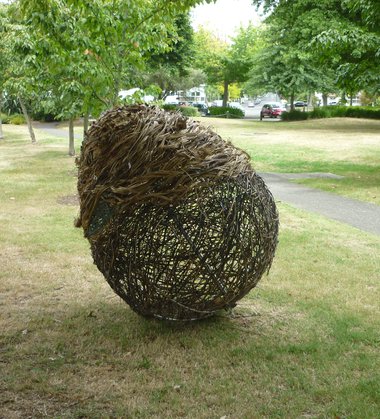



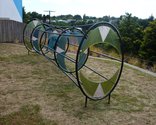
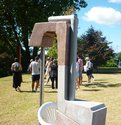


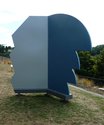
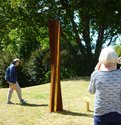

 Advertising in this column
Advertising in this column Two Rooms presents a program of residencies and projects
Two Rooms presents a program of residencies and projects



This Discussion has 0 comments.
Comment
Participate
Register to Participate.
Sign in
Sign in to an existing account.